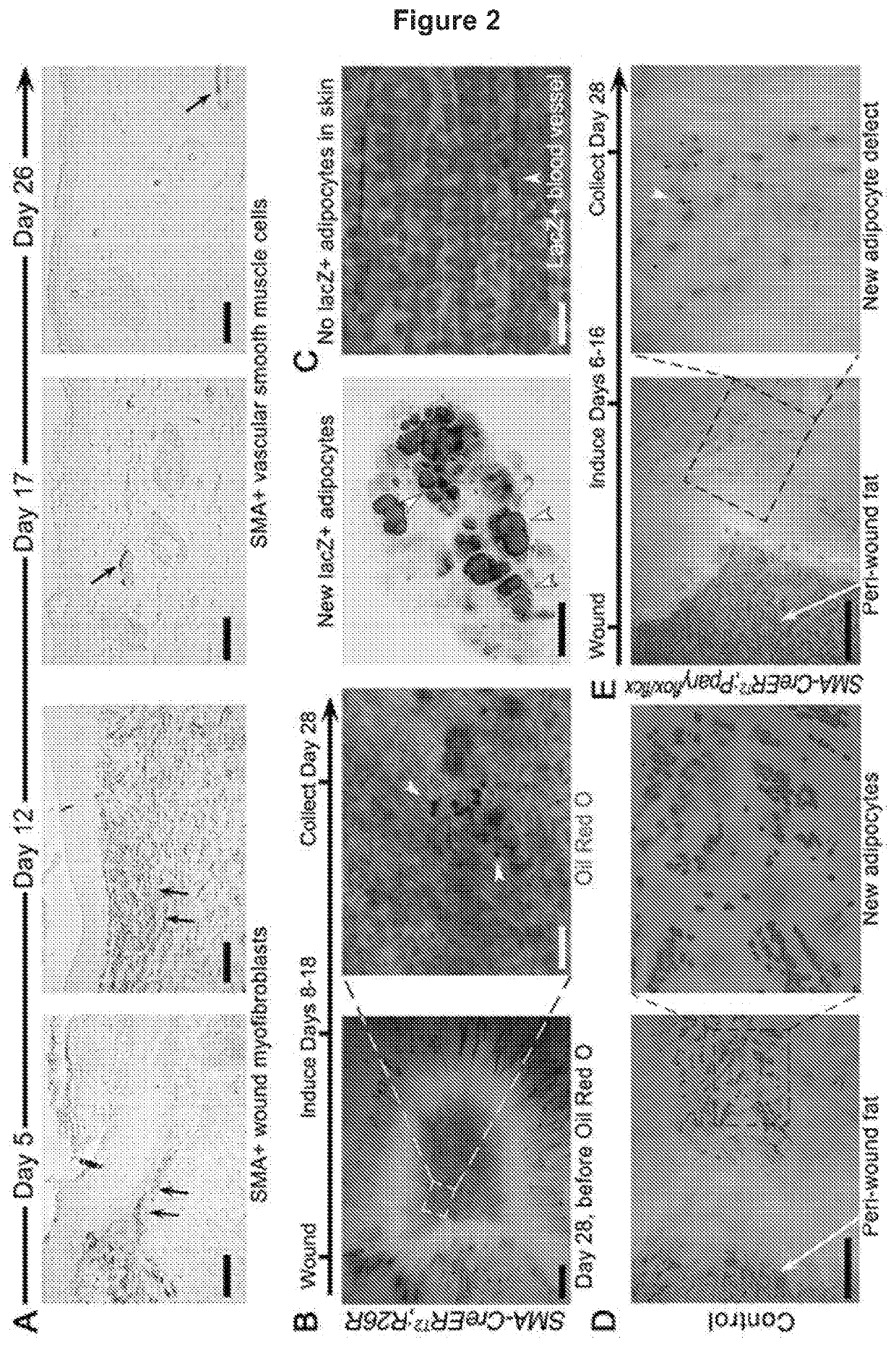Methods for scar reduction by converting scar fibroblasts into adipocytes with hair follicle-derived signals
a technology of scar fibroblasts and adipocytes, which is applied in the direction of drug compositions, skeletal/connective tissue cells, peptide/protein ingredients, etc., can solve the problems of scar fibroblasts almost universally recurring, and often affecting the appearance of scars, so as to reverse skin aging
- Summary
- Abstract
- Description
- Claims
- Application Information
AI Technical Summary
Benefits of technology
Problems solved by technology
Method used
Image
Examples
example 1
and Methods
[0121]Wounding Experiments.
[0122]All animal experiments were carried out in accordance to with the guidelines of the IACUC of the University of Pennsylvania and the University of California, Irvine. Full thickness 1.5×1.5 cm (2.25 cm2) excisional wounds were inflicted on the backs of three to eight week-old mice as described in M. Ito et al., Nature 447:316 (2007).
[0123]Phenotype Quantification Methodology.
[0124]Whole mount wounds were stained for Oil Red O and the number of regenerated hair follicles was counted from the skin surface, where each new hair is clearly visible. The number of new adipocytes was counted from the underside, where each adipocyte is clearly visible due to their very large size and prominent marking by Oil Red O dye. For each experiment, adipose tissue regeneration was quantified as the ratio of all new adipocytes / all new hair follicles (aka adipocyte / hair follicle index). The index values for all experiments, statistical significance and number o...
example 2
ion of Fat Cells from Mvofibroblasts During Wound Healing
[0147]Although regeneration via the reprogramming of one cell lineage to another occurs in fish and amphibians, it is not observed in mammals. During wound healing adipocytes to regenerate from myofibroblasts, a cell type thought to be differentiated and non-adipogenic was discovered in mouse. Myofibroblast reprogramming required neogenic hair follicles, which triggered BMP signaling and then activation of adipocyte transcription factors expressed during development. Overexpression of the BMP antagonist, noggin, in hair follicles or deletion of the BMP receptor in myofibroblasts prevented adipocyte formation. Adipocytes formed from human keloid fibroblasts when treated with either BMP or when placed with human hair follicles in vitro. Thus, the myofibroblast is identified as a plastic cell type that may be manipulated to treat scars in humans.
[0148]Wound healing in adult humans and mice generally results in a scar with excess ...
example 3
l Lineage Tracing Results
[0161]Several non-myofibroblast mesenchymal cell types display SM22 / SMA activity in and around the wound bed. These include vascular smooth muscle cells (VSMCs) of the wound and peri-wound blood vessels, subcutaneous skeletal muscle panniculus carnosus and dermal papilla cells of new hair follicles. To definitively establish that myofibroblasts are the key mesenchymal adipogenic progenitors in the wound, a series of additional lineage tracing experiments were performed. First, we took advantage of the fact that not all smooth muscle contractile proteins are expressed in myofibroblasts. Smooth muscle myosin heavy chain (SMMHC aka Myhl 1) is expressed exclusively by true smooth muscle cells (18) and is distinctly absent from wound myofibroblasts. Lineage tracing in the wounds of SMMHC-CreERT2;R26R mice was performed using two induction protocols: 30 days before wounding to label pre-existing VSMCs of the cutaneous blood vessels and their progeny (n=4) (FIG. 13...
PUM
 Login to View More
Login to View More Abstract
Description
Claims
Application Information
 Login to View More
Login to View More - R&D Engineer
- R&D Manager
- IP Professional
- Industry Leading Data Capabilities
- Powerful AI technology
- Patent DNA Extraction
Browse by: Latest US Patents, China's latest patents, Technical Efficacy Thesaurus, Application Domain, Technology Topic, Popular Technical Reports.
© 2024 PatSnap. All rights reserved.Legal|Privacy policy|Modern Slavery Act Transparency Statement|Sitemap|About US| Contact US: help@patsnap.com










